Innovative shoreline adaptation methods, such as nature-based solutions, can utilize a more natural approach to restore, enhance, and protect against coastal flooding and erosion. However, this is an emerging technique and barriers exist in local codes, zones, and permitting. PEP and New York SeaGrant work in coordination with local municipalities to review codes and policies, document hurdles, and suggest improvements that will result in these resilient shoreline adaptation methods becoming a more feasible option across the Peconic Estuary.
Who is involved?
Overall this work looks to answer the question- What factors are contributing to the issues faced in the process of thoughtful climate resilience planning on the shorelines of the Peconic Estuary? The Shoreline Adaptation Initiative synthesizes information gathered from partnerships within the many subgroups within it to leverage funds to create resources and draft policy/process changes to align decision-making, goals, and interpretation of shoreline policies in the Peconic Estuary.
Shoreline Management involves a host of stakeholders and affects all community members of the estuary.
Regulatory/Core Assessment Advisory Group: The Shoreline Adaptation Initiative works with an advisory group of Policy/lawmakers and regulatory review officials to understand the context of shoreline adaptation in the Peconic Estuary. This group is made up of representatives from NYDEC, PEP, NYSG, Suffolk County, DOS, and local government trustees and representatives.
Permit review happens at multiple layered regulatory agencies. This multi-jurisdictional review includes Federal, State, and local town levels. In certain areas of the Peconic Estuary, this process includes additional layers of village governments and Town Trustee regulatory review.
Land Managers/Homeowners: Shoreline Adaptation Initiative works with property owners, groups of property owners, and land managers along the shoreline to identify and document current internal permit process hurdles to collaboratively find meaningful solutions.
Implementers/Practitioners: The Shoreline Adaptation Initiative works to identify and document hurdles faced by implementers, from engineer and expeditors. Documenting this experience highlights the inter-agency and multi-jurisdictional challenges of completing a nature-based shoreline adaptation project as well as inspires future solutions that may benefit all stakeholders.
Policy Makers: Using information gathered at the many levels of the permitting process, the Shoreline Adaptation Initiative continuously collaborates with lawmakers as amendments to code & zone regulations and process solutions are recommended. This work will connect needed resources developed by partners to lawmakers and advisory committees to alleviate regulation hurdles.
The PEP Shoreline Adaptation Initiative refers to the greater effort of subgroups and advisory groups to review all 1:1 interviews and workshops with each stakeholder subgroup. Subgroups include implementation professionals and land owner/managing community groups. Subgroups & advisory groups represent each stakeholder’s perspective in the process of successful shoreline adaptation. Each group has expressed the need for resources and process documentation to make informed shoreline management decisions.

Shoreline Adaptation Initiative’s Mission
The initiative synthesizes information gathered from partnerships within the many subgroups within it to leverage funds and position to create resources and draft policy/process changes to align decision-making, goals, and interpretation of shoreline policies in the Peconic Estuary.
Our Long-Term Process:
- Assess current status of shoreline codes, policies, and processes with local municipalities
- Identify similarities and differences of codes, policies, and system processes across jurisdiction
- Workshop to review NYS model local laws and discuss how current town codes and policies can be adapted
- Connect information compiled on hurdles within the permitting process to highlight the effects of current policies in practice
- Draft change alongside municipalities & share lessons learned to create a system in which nature-based solutions are a viable option in the Peconic Estuary
Collection of Resources:
The initiative is in the midst of reviewing a collection of resources to be published in the 2025 PEP-NYSG Shoreline Adaptation Initiative Needs Assessment & Recommendation Document.
A preliminary list of resources is below & please email Jade.blennau@stonybrook.edu to share helpful resources related to this topic!
Permit Process:
A Guide to Permitting Shoreline Modification Projects in New York’s Tidal Waters: See Appendix C for list of NYS resources
Federal Permitting and Environmental Reviews for Nature-Based Solutions: A Best Practices Guide
Nature-Based Solution/Living Shoreline Resources:
Geographic Information Gateway: Living Shoreline DOS Story Map (NYS DOS)
NYSDEC Tidal Wetlands Guidance Document
NYS Community Risk and Resiliency Act (CRRA)
NYDEC Shoreline Stabilization Techniques
NYDEC Using Natural Measures to Reduce the Risk of Flooding and Erosion
Hardened Shorelines
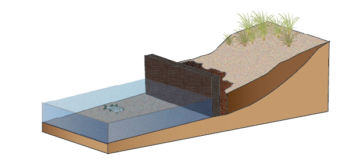
When hard shoreline structures are hit by waves, energy is reflected further down the shoreline disrupting natural sediment movement patterns and altering the shape of the coast. This process can alter the erosion and deposition patterns of sandy sediments, ultimately leading to shoreline destabilization. This destabilization can create problems for surrounding areas and may encourage nearby landowners to install hard structures along their property as well, further exacerbating the problem.
This “domino effect” of replacing a natural shoreline with hard structures can result in the loss of important coastal habitats, including wetlands, beaches, and eelgrass beds. Habitat loss can negatively impact the fishing and tourism industries, as well as the wildlife that rely on these areas for feeding, reproduction, or nursery grounds.
Wave energy is reflected by hardened shorelines, leading to further shoreline destabilization.
Living shorelines absorb and dissipate wave energy and allow for natural water and sand movement patterns, preventing beach destabilization.
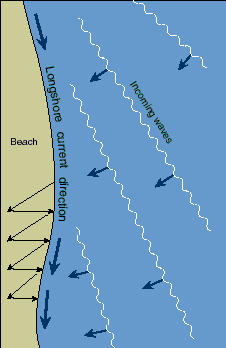
When waves hit the beach at an angle, sand is transported alongshore by wave energy. Waves also transport sand along the shore in a zig-zag pattern as they rush onto and off of the beach. This natural movement of sand is disrupted by hardened shorelines, which reflect wave energy and disrupt natural sand movement patterns, leading to erosion. Image taken from USGS.
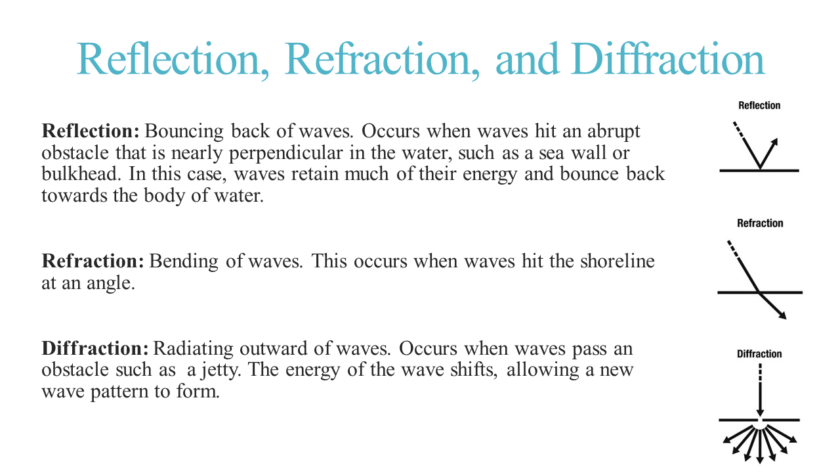
Hard shoreline structures also cause other problems—they can leach toxins, such as copper, chromium, and arsenic, into the surrounding water, further impacting the ecosystem. Additionally, these barriers prevent the natural migration of marshes inland as sea level rises, leading to their loss instead of allowing for their adaptation. Loss of marsh habitat negatively impacts wildlife and plant populations and makes Long Island more vulnerable to coastal flooding, erosion, and storm damage.
With continued sea level rise and a potential increase in storm frequency and intensity due to a changing climate, there is a growing demand for shoreline protection on Long Island. The impacts of hardened shorelines are well established. Developing alternative forms of shoreline protection that do not negatively impact our shorelines, while also providing benefits to our coastal ecosystem, is a priority for PEP.
Living Shorelines
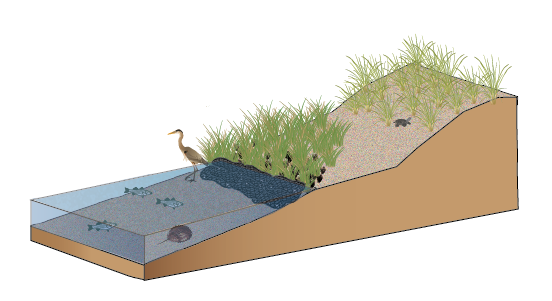
‘Living shorelines’ are a beneficial alternative to hardened shorelines. These ‘soft’ shorelines use native plants, shellfish, and other natural features such as rocks, sand, wood, coconut fiber, and shells to stabilize and protect coasts and decrease direct wave energy. Living shorelines are designed to mimic the natural environment and provide ecological benefits.
Benefits of Living Shorelines
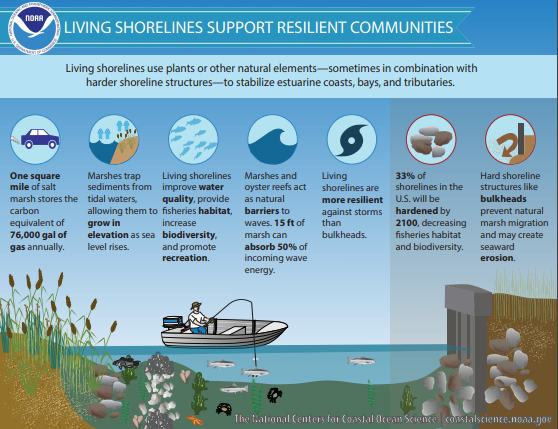
Related Content
- Resilient Communities Prepared for Climate Change
Peconic Estuary Partnership leads scientifically informed, proactive efforts by local communities that can reduce the negative impacts of climate change. Learn more about climate change resilience in coastal communities here. - Peconic Estuary Partnership - Healthy Ecosystems with Abundant, Diverse Wildlife
Peconic Estuary Partnership is working to build scientific understanding and support decision-making to address threats to habitat and species. Learn more about the many important habitats of the Peconic Estuary and how we can better protect them.
More Resources
- NYSDEC Tidal Wetlands Guidance Document (2017)
DEC document including helpful instructions to guide the creation of a living shoreline. - NOAA Living Shorelines
NOAA webpage with helpful diagrams and descriptions regarding living vs. hardened shorelines. - USGS Waves and Currents
USGS image describing the longshore current and resultant sand transport along a typical beach.
